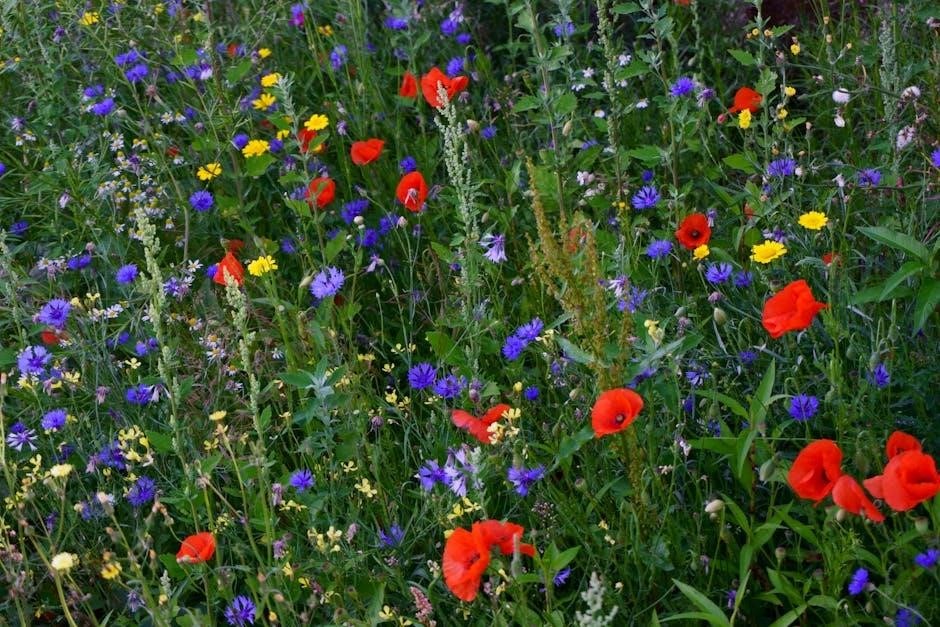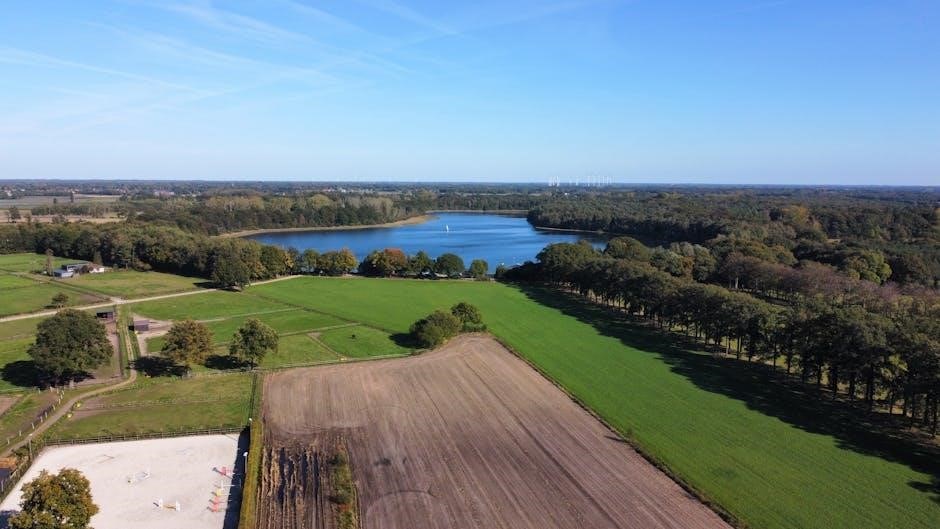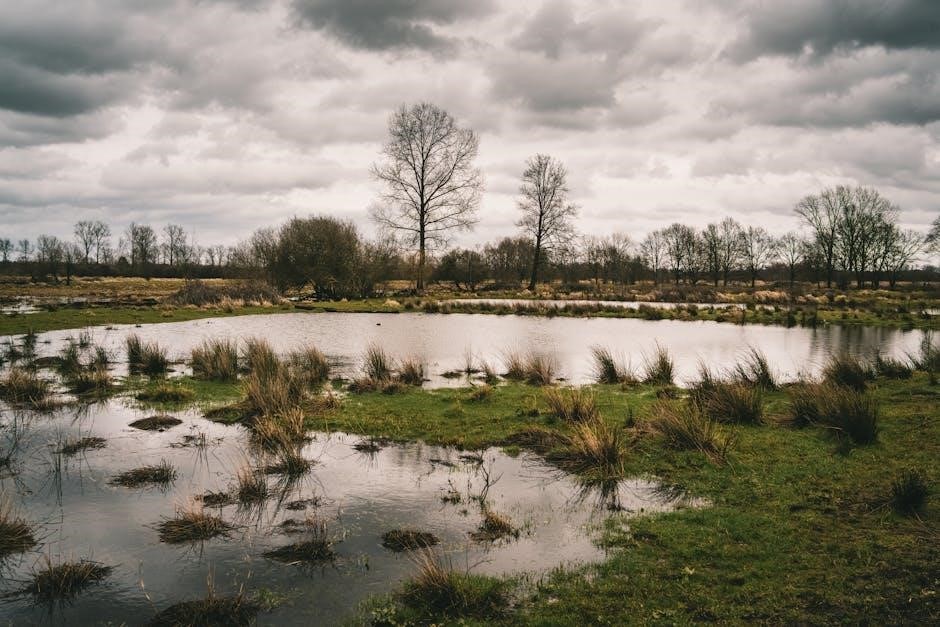Written by John McCrae in 1915‚ “In Flanders Fields” is a poignant reflection on the sacrifices of World War I soldiers. The poem’s vivid imagery and poppy symbolism have made it a cultural icon‚ symbolizing remembrance and loss. Available as a free PDF download‚ it remains a powerful tribute to the fallen‚ inspiring generations to honor their legacy.
1.1 Historical Context of the Poem
“In Flanders Fields” was written in 1915 by John McCrae‚ a Canadian physician and soldier‚ during World War I. Inspired by the funeral of his friend Alexis Helmer‚ who died in the Second Battle of Ypres‚ the poem captures the devastation of war. The battle introduced chemical weapons‚ causing unprecedented suffering. McCrae’s vivid imagery reflects the horrors of modern warfare and the sacrifice of soldiers. The poem became a symbol of remembrance‚ particularly through its poppy motif. Its historical significance lies in its ability to convey the emotional toll of conflict. Today‚ the poem is widely studied and available as a PDF download for educational purposes‚ ensuring its legacy endures.

1.2 Significance of the Poppy Symbolism

The poppy in “In Flanders Fields” symbolizes the bloodshed and sacrifices of soldiers during World War I. Growing in the battle-scarred fields of Flanders‚ the poppy became a natural emblem of remembrance. McCrae’s poem popularized the flower as a symbol of honor for the fallen. Today‚ the poppy is internationally recognized as a token of respect and mourning‚ worn on anniversaries like Remembrance Day. Its enduring imagery evokes gratitude for those who gave their lives. The poppy’s significance extends beyond the poem‚ connecting generations to the historical and emotional impact of war‚ making it a lasting motif in cultural memory.

The Author: John McCrae
John McCrae‚ a Canadian physician and soldier‚ wrote “In Flanders Fields” during World War I. His dual role as a healer and warrior deeply influenced his poetry.
2.1 Biography of John McCrae

John McCrae‚ born on November 30‚ 1872‚ in Guelph‚ Ontario‚ was a Canadian physician‚ soldier‚ and poet. He studied medicine at the University of Toronto and later served in the Boer War. During World War I‚ McCrae joined the Canadian Expeditionary Force as a lieutenant-colonel and served as a field surgeon. His experiences during the Second Battle of Ypres deeply influenced his writing‚ leading to the creation of “In Flanders Fields.” McCrae’s dual role as a healer and soldier gave his poetry a unique perspective on war’s brutality and sacrifice. He passed away on January 28‚ 1918‚ but his legacy endures through his iconic poem‚ which has become a symbol of remembrance worldwide.
2;2 His Role in World War I
During World War I‚ John McCrae served as a lieutenant-colonel in the Canadian Expeditionary Force‚ acting as a field surgeon. He witnessed the devastating effects of modern warfare firsthand‚ particularly during the Second Battle of Ypres. McCrae’s medical expertise was crucial in treating wounded soldiers‚ but the immense loss of life deeply affected him. His friend’s death inspired him to write “In Flanders Fields‚” which captures the futility and horror of war. McCrae’s role extended beyond medicine; his poetry became a powerful voice for soldiers’ sacrifices‚ earning him recognition as a significant war poet. His experiences shaped his literary contributions‚ immortalizing the atrocities of the Great War.
2.3 Other Literary Works

While “In Flanders Fields” remains John McCrae’s most celebrated work‚ he contributed to other literary endeavors. His collection‚ In Flanders Fields and Other Poems‚ published posthumously‚ features verses that reflect his patriotism‚ love for nature‚ and contemplation of life. These poems‚ though less renowned‚ offer insights into McCrae’s broader artistic vision. The collection is available as a PDF download‚ allowing readers to explore his complete literary legacy. McCrae’s writings‚ beyond his iconic war poem‚ highlight his skill in capturing emotion and themes relevant to his era‚ showcasing his versatility as a poet and thinker.
The Poem’s Themes and Analysis
“In Flanders Fields” explores themes of war‚ sacrifice‚ and remembrance‚ using the poppy as a symbol of life and death. Its vivid imagery conveys the human cost of conflict.
3.1 Themes of War and Sacrifice
“In Flanders Fields” vividly captures the horrors of war and the profound sacrifices made by soldiers. The poem reflects on the futility of conflict‚ where lives are lost amidst the chaos. The poppy‚ a symbol of bloodshed‚ represents the fallen soldiers who lie in the fields of Flanders. McCrae’s vivid imagery conveys the human cost of war‚ emphasizing the emotional toll on those who remain. The poem urges remembrance and honor for the dead‚ serving as a poignant reminder of the sacrifices made during World War I. Its themes resonate deeply‚ evoking a sense of duty to ensure such losses are not forgotten. The poem’s legacy endures as a powerful anti-war statement.

3.2 Literary Devices and Structure
“In Flanders Fields” employs powerful literary devices to convey its themes. The poem uses vivid imagery‚ such as “poppies blow” and “crosses‚ row on row‚” to paint a haunting battlefield scene. Alliteration and rhyme‚ like “fly Scarce heard amid the guns below‚” create a rhythmic‚ almost musical quality. Personification is evident as the dead speak directly to the living‚ deepening the emotional impact. The structure‚ consisting of four stanzas with an ABAB rhyme scheme‚ adds to the poem’s lyrical and reflective tone. McCrae’s use of metaphor‚ particularly the poppy as a symbol of remembrance‚ underscores the poem’s enduring message of sacrifice and duty. These devices collectively enhance the poem’s emotional resonance and timeless appeal.
3.3 Emotional Impact and Reception
“In Flanders Fields” has left an indelible mark on readers worldwide‚ evoking profound emotions tied to loss‚ sacrifice‚ and remembrance. Its vivid imagery and poignant tone resonate deeply‚ particularly during commemorations like Remembrance Day. The poem’s ability to personify the fallen soldiers‚ urging the living to continue their legacy‚ creates a sense of duty and reflection. Its emotional depth has made it a cornerstone of wartime literature‚ inspiring countless tributes and educational resources. The widespread availability of the poem in PDF format ensures its message reaches new generations‚ preserving its relevance and emotional impact. Its timeless appeal continues to honor the sacrifices of those who served.
Educational Resources and Downloads
Educational resources for “In Flanders Fields” include PDF downloads‚ lesson plans‚ and study guides‚ offering insights into the poem’s themes‚ historical context‚ and literary significance for students and educators.
4.1 PDF Downloads of the Poem

“In Flanders Fields” is widely available as a free PDF download from reputable sources like The Library of Congress and Project Gutenberg. These downloads offer the poem in its original form‚ often accompanied by historical context and annotations. Teachers and students can access these resources for educational purposes‚ while readers can enjoy the poem on various devices. The PDF format ensures clarity and readability‚ making it ideal for classroom use or personal reflection. Additionally‚ some versions include biographical information about John McCrae‚ enhancing the reader’s understanding of the poem’s origins and significance. These downloads are a convenient way to explore the timeless message of “In Flanders Fields” in a digital format.
4.2 Lesson Plans and Study Guides
Lesson plans and study guides for “In Flanders Fields” are widely available‚ offering educators and students a deeper understanding of the poem’s themes and historical context. These resources often include activities‚ discussion prompts‚ and analysis of literary devices like symbolism and imagery. Many guides‚ such as those from the Library of Congress and Teachers Pay Teachers‚ provide downloadable materials that align with educational standards. They also explore the poem’s emotional impact and its relevance to Remembrance Day. Suitable for various grade levels‚ these tools enhance classroom engagement and facilitate meaningful discussions about war‚ sacrifice‚ and remembrance. They are ideal for integrating the poem into English Language Arts curricula.
4.3 Readers Theater Scripts
Readers Theater scripts for “In Flanders Fields” offer an engaging way to bring the poem to life in educational settings. These scripts adapt the poem into a dramatic format‚ with roles designed for students to act out the story of Dr. John McCrae and the historical context of World War I. Many scripts include multiple reading levels to accommodate diverse learners‚ fostering participation and teamwork. They also emphasize the poem’s themes of sacrifice‚ remembrance‚ and the symbolism of the poppy. By performing these scripts‚ students gain a deeper understanding of the poem’s significance and its connection to global history. This resource is particularly popular in classrooms celebrating Remembrance Day or studying World War I literature.

Cultural and Historical Legacy
“In Flanders Fields” transformed the poppy into a global remembrance symbol‚ honoring war sacrifices. Its legacy endures in tributes‚ literature‚ and collective memory‚ ensuring timeless impact.
5.1 The Poppy as a Symbol of Remembrance
The poppy‚ central to “In Flanders Fields‚” has become an enduring symbol of remembrance for lives lost in war. Inspired by the poem‚ the poppy was adopted as a tribute to soldiers’ sacrifices‚ particularly during World War I. It is now a global emblem‚ used in remembrance ceremonies and worn on lapels to honor the fallen. The poppy’s red color symbolizes bloodshed and resilience‚ while its growth in Flanders Fields represents life amidst devastation. Its adoption by organizations like the Royal British Legion has cemented its cultural significance‚ ensuring the poem’s legacy endures as a powerful tribute to the fallen.
5.2 Commemoration Events
Commemoration events honoring the legacy of “In Flanders Fields” are held annually‚ particularly on Remembrance Day. These events often feature readings of the poem‚ ceremonies at war memorials‚ and the distribution of poppy symbols. Educational institutions incorporate the poem into their curricula‚ using PDF downloads and study guides to explore its themes. The centenary of the poem’s publication in 2015 was marked with special tributes‚ including exhibitions and literary discussions. These events ensure the poem’s message of sacrifice and remembrance continues to resonate‚ fostering a connection to history for new generations while honoring the fallen soldiers it commemorates.
5.3 Impact on Modern Literature
“In Flanders Fields” has left an indelible mark on modern literature‚ inspiring generations of writers and poets. Its vivid imagery and emotional depth have influenced war poetry‚ emphasizing themes of sacrifice and remembrance. The poem’s structure and rhyme scheme have been studied and emulated‚ setting a standard for expressive yet concise storytelling. Its symbolism‚ particularly the poppy‚ has become a universal emblem of war’s cost. Contemporary authors often draw on its themes of mortality and nationalism‚ while educators use PDF study guides to explore its literary devices. The poem’s enduring relevance ensures it remains a cornerstone of literary analysis‚ bridging the past with modern reflections on conflict and loss.
“In Flanders Fields” remains a timeless tribute to the sacrifices of World War I‚ resonating deeply with readers today. Its vivid imagery and poignant themes of loss and remembrance have cemented its place in literary history. The poem’s symbolism‚ particularly the poppy‚ continues to inspire reflection on the cost of war. As a cultural icon‚ it is widely studied‚ with PDF downloads and educational resources making it accessible to new generations. John McCrae’s masterpiece not only honors the fallen but also serves as a reminder of the enduring impact of conflict. Its legacy endures‚ ensuring that the voices of the past continue to echo in the present.
Comments